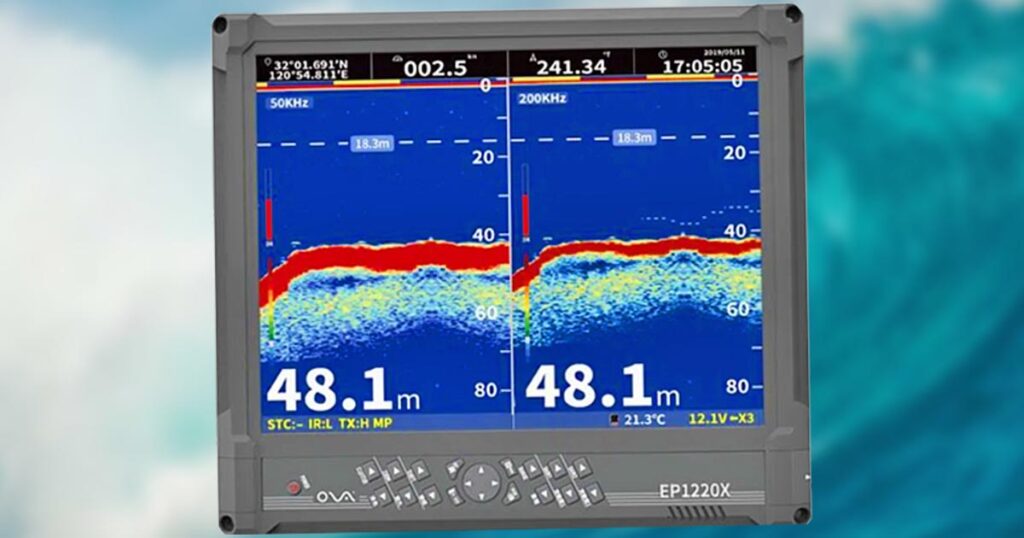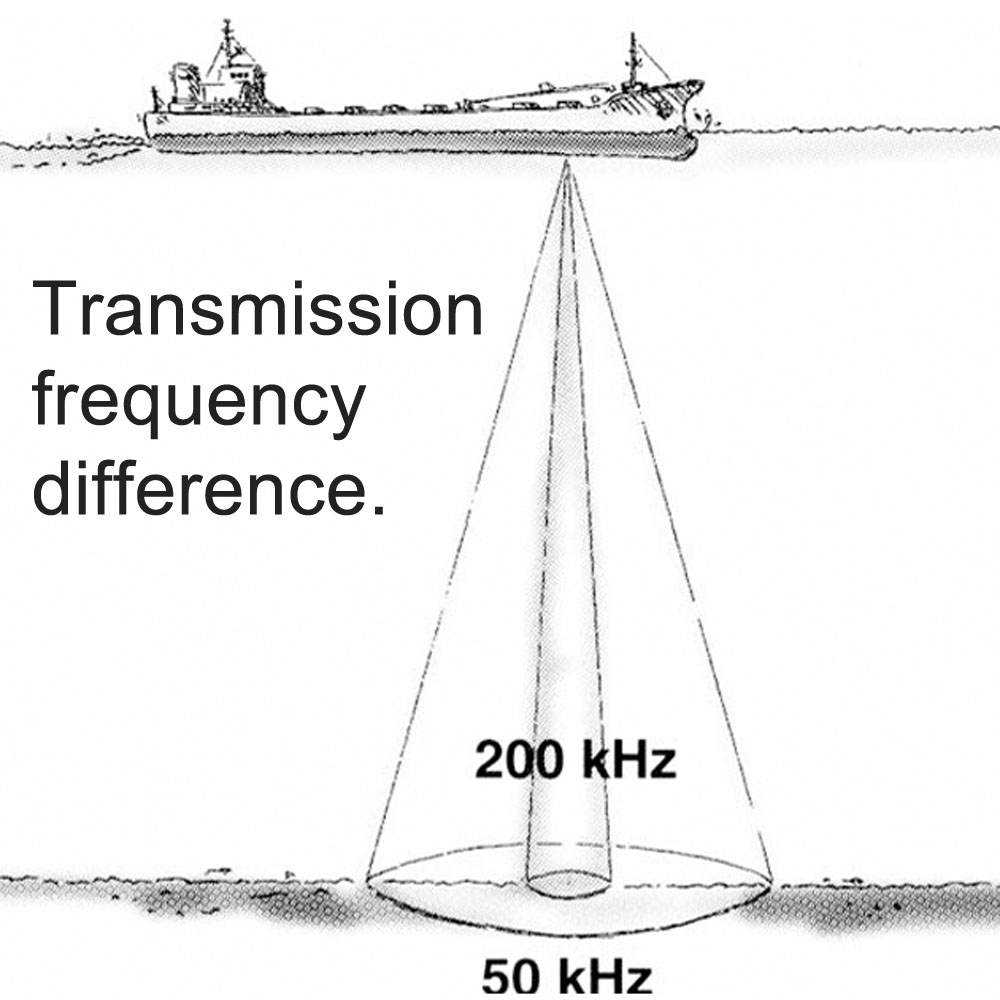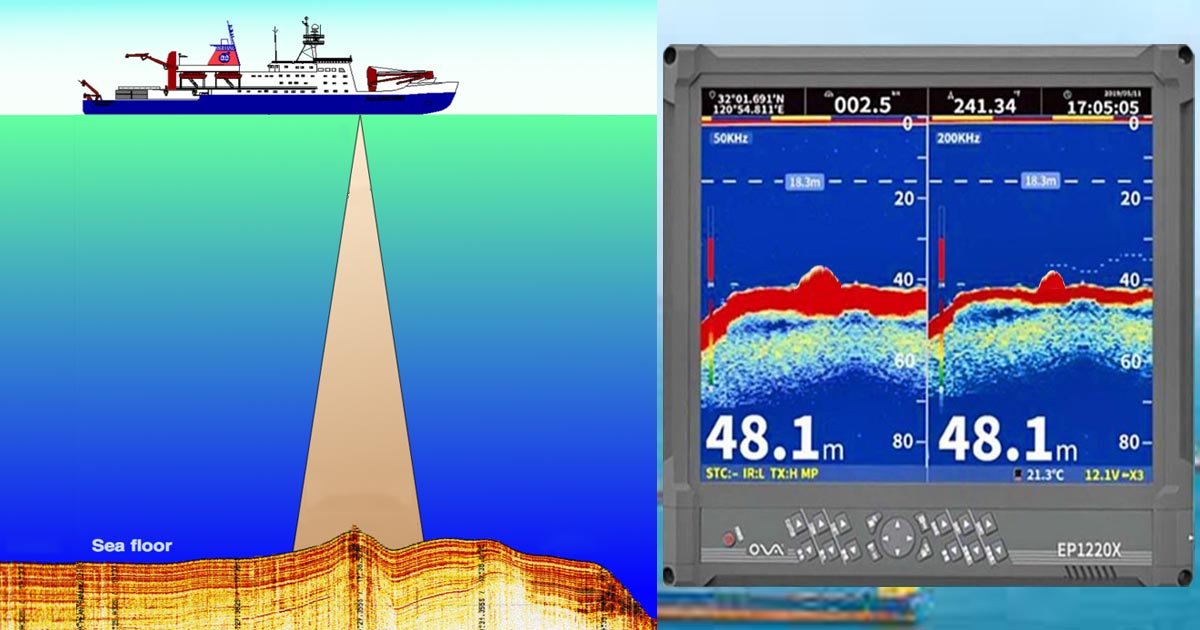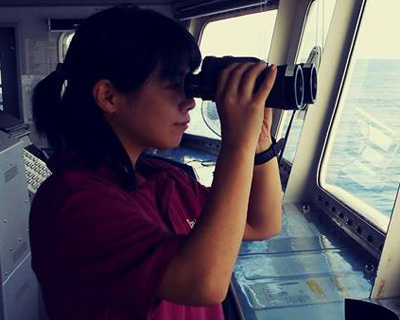An echo sounder is the only device on board that measures the depth of water below a ship’s keel in real time.
While seafarers must be aware of conditions on the sea surface, this sounding equipment allows them to know if the underwater terrain is safe for navigation.
While hydrographic surveyors use echo sounders to map the ocean floor and gather underwater topography data, seamen depend on on this depth sounding device to keep the vessel clear of shallow waters.
Key Takeaways
- An echo sounder gauges the distance between the ship’s hull and the sea floor, while a marine radar helps seafarers measure the range of targets around them.
- The transducer pings the echo and receives it back for depth calculation.
- There are two types of echo sounders: single-beam echo sounders, which are used by merchant vessels, and multi-beam echo sounders, which are used for hydrographic survey and bathymetry.
- SOLAS and IMO outline the use of depth sounders.
What is an Echo Sounder?
An echo sounder, also known as a depth sounder or fathometer, is an electronic device that measures and displays the available depth of water under the ship’s hull.
It is one of the most important navigational tools every ship must have!
To measure depth, an echo sounder works by emitting sound waves from a transducer mounted on the bottom of the ship.
These sound waves travel down through the water, bounce off the seabed, and then return to the transducer.
By measuring the time it takes for the sound waves to travel this round trip, this depth measuring device can calculate the water depth.
Two Types of Echo Sounders
There are two types of echo sounders, and they differ by the beam or echo they emit.
1. Single Beam Echo Sounders (SBES) – fishing vessels and merchant ships use these types of depth sounders. They work by “pinging” the waters and measuring the time it takes for the echo to return.
2. Multi-Beam Echo Sounders (MBES) – for vessels mapping the topography of the sea floor, a multi-beam echo sounder is the go-to equipment.
Instead of one sound pulse, it transmits multiple beams in a fan-shaped swath perpendicular to the ship’s track.
The resulting data produces high-resolution 3D maps while covering larger areas with each pass.

How do seafarers use an Echo Sounder for navigation?
Just as marine radars help seafarers identify dangers in their surroundings, echo sounders serve as our eyes underwater.
By knowing the available depth of the waters beneath the ship’s hull, we can adjust our speed to minimize the squat effect we may encounter.
Here are more ways seamen use depth sounders in real-time:
1. Measure water depth – Its primary function is to measure the depth of water underneath the ship’s hull.
2. Prevent grounding – By seeing the UKC decreasing contrary to the charted depth, we can re-assess our position to prevent grounding.
3. Verify nautical charts – Echo sounders verify if the charted depths in navigational charts match real-time readings. This helps validate chart accuracy.
4. Monitor draft/ under keel clearance – The depth reading is compared with the ship’s draft to determine available keel clearance from the seabed.
Knowing the UKC is very important and is one of the essential part of the voyage plan.
5. Navigate in unfamiliar waters – Echo sounders help monitor and gather essential depth information when sailing in unfamiliar or poorly charted waters.
This helps seafarers navigate confidently, especially in areas where chart data is old or inaccurate.
6. Make tight turns – Navigating narrow channels may involve sharp turns. If the water depth is very shallow, this can be a problem.
Using the echo sounder to observe the depth helps seafarers limit their rudder angles and turn rate by monitoring the rate of turn indicator to prevent the ship from listing too much.
7. Monitor depth changes – Echo sounders monitor the water depth in real time and plot it in a graph.
When a ship detects shallow water, this device will sound an alarm, making us aware of the situation below the ship’s hull.
We can then mark that part in the chart for reference and caution the next time we pass that area.
How does an Echo Sounder work?
An echo sounder works based on the sound wave reflection principle to determine the water depth beneath a vessel.
It’s highly similar to radar except that the medium of operation is used underwater. Hence, this technology uses the SONAR principle or SOund Navigation And Ranging.
Working principles
Here is how an Echo Sounder typically operates:
1. Transmitting the Sound Pulse – The Echo Sounder sends a short pulse of sound, usually in the form of a high-frequency acoustic signal, from the transducer- a device mounted on the ship’s hull, towards the seabed.
The duration of the transmitter pulse and the pulse repetition frequency (PRF) are critical parameters in this system.
Typical beam widths for transmitting the sound pulse can be 50 kHz for low frequency and 200 kHz for high frequency.

2. Sound Wave Propagation – The sound pulse travels through the water until it reaches the seabed.
The speed of sound in water is relatively constant at 1,500 meters per second. It allows for accurate calculations of the time taken for the sound pulse to travel to the seabed and back.
3. Echo Reception – When the sound pulse hits the seabed, it reflects back towards the transducer. This reflected sound wave is known as an echo.
4. Calculating Depth – The Echo Sounder measures the interval between transmitting the sound pulse and receiving the echo.
By knowing the speed of sound in water, the device can calculate the depth of the water based on the time taken for the echo to return.
5. Displaying Depth – The calculated depth information is displayed on the Echo Sounder’s screen, providing real-time depth readings to the operator.
The display, which is inside the ship’s bridge, can be a traditional paper recording or a modern digital one.
It also offers five basic ranges between 0 meters and 2,000 meters.
6. Interpreting Data – Seafarers interpret the depth readings to navigate safely, avoid shallow areas, and make informed decisions while operating the vessel.
The device also integrates with the ECDIS and display console for better monitoring.
Where is it installed?
The display and transceiver data are configured inside the bridge. Meanwhile, you can find the transducer mounted under the ship’s hull.
Before installing the transducers, these three things must be considered for optimal use:
- Transducer depth – to avoid aeration of the sensors, it is wise to install it as deep as possible.
- Engine and propeller noise – they can mess with the echo pulse, reducing the effective range of the returning echo.
- Mechanical vibrations – the transducer unit must be installed as far away from strong vibrations as possible, such as in the engine room or propeller.
- Near obstructions – avoid installing the unit near bow thrusters, water intake/ outtake pipes, and speed log signals.
Considering all these factors, most transducers are located on the forward half of the ship.

When to use or activate the Echo Sounder
It is of primary importance to operate the depth sounder when draft and depth navigation require close monitoring of the seabed.
Here are some situations when using or activating the echo sounder is crucial:
- On arrival or sailing from the anchorage area.
- Entering or leaving harbors.
- Sailing up or down rivers.
- In any case where the draft in shallow waters limits or restricts the ship’s navigation.
- Where the swell is extremely deep, although the charted depths are considered safe.
- In geographical areas where the tide provides low water height equal to or below the chart datum (negative height).
- In any case, while navigating in shallow waters, uncharted or newly reported wrecks.
- When passing above the coral bottom, where the coral heads may grow and change the seabed since the last hydrographic survey.
- Where warnings on the chart display “inadequate survey” or “unsurveyed area”.
- In any case where the navigator doubts the fidelity of the charted depths.
The OOW must record any deviation of the depth sounder readings from the calculated UKC (higher or lower) on the nautical chart.
You must also call the master so he can make better decisions and inform the company or the traffic monitoring services.
Why do ships need Echo Sounders?
Echo sounders are needed on ship for safety purposes. This tool is also a requirement under SOLAS Regulation.
SOLAS Convention under Chapter V, Regulation 19, paragraph 2.3.1 states that:
All ships of 300 gross tonnage and upwards and passenger ships, irrespective of size shall, … be fitted with:
an echo-sounding device, or other electronic means, to measure and display the available depth of water.
Furthermore, the International Maritime Organization (IMO) lays out a groundwork for the performance standard of echo sounders under Resolution A.224(VII) and Annex 4 of Resolution MSC 74(69).
Undoubtedly, echo sounders are vital to ships of every size due to their contribution to safety.
Even with the advancements in marine technology, this device will still be part of a ship’s navigational system.
May the winds be in your favor.



0 Comments